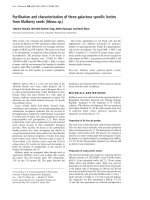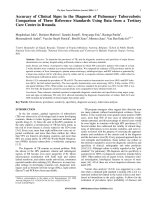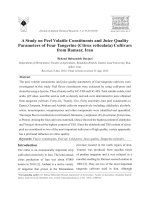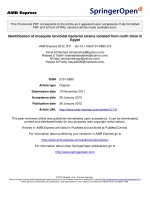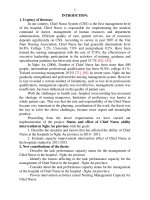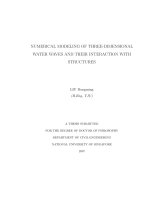Volatile constituents of three Thymus sipyleus Boiss. subspecies from different sites in Turkey
Bạn đang xem bản rút gọn của tài liệu. Xem và tải ngay bản đầy đủ của tài liệu tại đây (337.28 KB, 9 trang )
Turkish Journal of Chemistry
Turk J Chem
(2021) 45: 1959-1967
© TÜBİTAK
doi:10.3906/kim-2103-6
/>
Research Article
Volatile constituents of three Thymus sipyleus Boiss. subspecies from different sites in Turkey
1,
1
2
3
Hale Gamze AĞALAR *, Mine KÜRKÇÜOGLU , Kemal Hüsnü Can BAŞER , Kenan TURGUT
1
Department of Pharmacognosy, Faculty of Pharmacy, Anadolu University, Eskişehir, Turkey
2
Department of Pharmacognosy, Faculty of Pharmacy, Near East University, Lefkoşa, North Cyprus
3
Department of Field Crops, Faculty of Agriculture, Akdeniz University, Antalya, Turkey
Received: 04.03.2021
Accepted/Published Online: 20.09.2021
Final Version: 20.12.2021
Abstract: This study was designed to reveal the chemical diversity of some Thymus sipyleus subspecies growing wild in Turkey and to
compare the volatile compound profiles by using micro(hydro)distillation technique. For this purpose, volatile compounds isolated by
microdistillation from nine samples (three plant samples collected from different regions in Antalya) of Thymus sipyleus Boiss. subsp.
sipyleus var. sipyleus, T. sipyleus Boiss. subsp. sipyleus var. davisianus Ronniger, and T. sipyleus Boiss. subsp. rosulans (Borbas) Jalas
were analyzed by GC and GC-MS systems. 1,8-Cineole, p-cymene, α-terpineol and carvacrol were identified as major compounds in
T. sipyleus subsp. sipyleus var. sipyleus samples. Geranial, neral, 1,8-cineole and β-caryophyllene, and α-terpineol and geranial were
the main compounds in T. sipyleus subsp. sipyleus var. davisianus samples. β-Caryophyllene, intermedeol, 1,8-cineole and α-terpineol,
α-pinene were the major compounds in T. sipyleus subsp. rosulans samples. As known, thymol is the main compound in most Thymus
species in Turkey, but, according to our study, chemical polymorphism has been found among the T. sipyleus subspecies.
Key words: Thymus sipyleus subsp. sipyleus var. sipyleus, T. sipyleus subsp. sipyleus var. davisianus, T. sipyleus subsp. rosulans,
microdistillation, GC and GC-MS analysis, chemical polymorphism, terpenes
1. Introduction
The genus Thymus is note-worthy among the numerous species and varieties of wild-growing aromatic plants belonging
to the family Lamiaceae. Many of these species are typical for the Mediterranean area. The genus Thymus is represented
by 42 species and 47 taxa, 20 of which are endemic in Turkey [1]. All of them produce essential oils, and only a few are
important herbs used in all parts of the world. Most of the terpenoid volatiles detected in Thymus oils belong to the
monoterpene group. Sesquiterpenes are always present, but with only a few exceptions in minor percentages [2].
Most of these taxa growing in Turkey are aromatic plants which are generally used as herbal tea, condiments and in folk
medicine. Carvacrol and thymol are abundant monoterpenes in the essential oils of this genus. However, there are Thymus
species poor in phenolic compounds and some do not contain phenolic compounds at all. Phenol-rich Thymus species are
used in diabetes, stomach and intestinal diseases, for cough as herbal tea and also as a condiment; whereas, phenol-poor
or phenol-less Thymus species are used, due to their pleasant aroma, as herbal tea in Turkey [3].
Thymus L. is known in the world as ‘thyme’ and in Anatolia as ‘kekik’ or ‘kaya kekiği’. Volatile oils of thyme are used
as antiseptics, antispasmodics and fungicidal [4, 5]. The antiseptic, antioxidative, insecticidal, preservative and anaesthetic
properties of thyme are due to their biologically active substances, such as thymol, carvacrol, linalool, geraniol and other
volatiles in the essential oil [6]. In addition to the plant applications, thyme oils are also used in flavour and food industries,
mainly in the manufacture of perfumes and cosmetics, or for flavouring chocolates, toothpaste, mouthwashes [7].
Due to the high economic value of Thymus species, a high number of studies on several aspects of this genus are
available as well as the existing monographs on Thymus in Pharmacopoeias [8–10].
Thymus sipyleus Boiss. is endemic in Turkey, and known with local Turkish names as “kekik, limon kokulu kekik,
keklik otu, yayla kekiği, nemamul otu, sater” [11]. According to ethnobotanical records, T. sipyleus and its subspecies are
used for different purposes. In Adana, infusion of branches and leaves are consumed before meals for the treatment of
stomach aches [12]. The aerial parts of T. sipyleus subsp. sipyleus var. sipyleus and T. sipyleus subsp. sipyleus var. rosulans
are used as spice and tea (dried and grounded), in the treatment of haemorrhoids, atherosclerosis, and stomach disorders
in Osmaneli, Bilecik [13]. The leaves of both subspecies also boiled with lemon as tea are taken against common cold and
*Correspondence:
This work is licensed under a Creative Commons Attribution 4.0 International License.
1959
AĞALAR et al. / Turk J Chem
coughs in Sivas and Yozgat [14]. In Ulukışla, Niğde, an infusion of the aerial parts of T. sipyleus subsp. sipyleus var. sipyleus
is consumed three times a day for colds and stomach aches [15]. T. sipyleus subsp. rosulans known as “catri” in the Eastern
part of Turkey is used for diabetes, colds, abdominal ailments as an infusion and decoction [16].
The present study is focused on determining the variation of volatile compounds from different populations of Thymus
sipyleus Boiss. subsp. sipyleus var. sipyleus, T. sipyleus Boiss. subsp. sipyleus var. davisianus Ronniger, and T. sipyleus Boiss.
subsp. rosulans (Borbas) Jalas. To date, the oil composition, biological activities of these subspecies of Thymus sipyleus have
been reported [3, 11, 17–19]. In the present study, microdistilled aerial parts of T. sipyleus subsp. sipyleus var. sipyleus, T.
sipyleus subsp. sipyleus. var. davisianus, and T. sipyleus subsp. rosulans collected from different regions of Antalya, Turkey
were analyzed by GC and GC-MS systems, simultaneously. Each microdistilled sample was characterized with major and
minor volatile constituents by using in house and commercial libraries.
2. Materials and methods
2.1. Plant material
Air dried aerial parts of T. sipyleus subsp. sipyleus var. sipyleus (KT:190, 191, 192), T. sipyleus subsp. sipyleus var. davisianus
(KT:196, 197, 198) and T. sipyleus subsp. rosulans (KT:199, 200, 201) were collected from three regions in Elmalı, Saklıkent,
Gazipaşa (Antalya), respectively (Table 1). Identification of plant samples was done by one of us (KT). All herbarium
samples coded as KT were kept at the Department of Field Crops, Faculty of Agriculture, Akdeniz University, Antalya,
Turkey.
2.2. Isolation of the volatiles
Each sample was obtained by microdistillation of the dried, ground plant material (50 mg) using an Eppendorf
MicroDistiller with 10 mL distilled water per sample vial. The sample vial was heated to 108 °C at a rate of 20 °C/min and
kept at this temperature for 90 min, then heated to 112 °C at a rate of 20 °C/min and kept at this temperature for 30 min.
The sample was subjected to a final postrun for 2 min under the same conditions. The collecting vial, containing a solution
of NaCl (2.5 g, Sigma-Aldrich) and water (0.5 mL, ultrapure) plus 350 µL of n-hexane [Sigma-Aldrich, ≥99% (GC)] to
trap volatile components, was cooled to –5 °C during distillation. After the distillation was completed, the organic layer in
the collection vial was separated and analyzed by gas chromatography (GC) and gas chromatography-mass spectrometry
(GC-MS) systems, simultaneously.
2.3. GC analysis
The GC analysis was carried out using an Agilent 6890N GC system. FID detector temperature was 300 °C. To obtain
the same elution order with GC-MS, simultaneous autoinjection was done on a duplicate of the same column applying
the same operational conditions. Relative percentage amounts of the separated compounds were calculated from FID
chromatograms. The results of the analysis are shown in Table 2.
2.4. GC-MS analysis
The GC-MS analysis was carried out with an Agilent 5975 GC-MSD system. Innowax FSC column (60 m × 0.25 mm, 0.25
mm film thickness) was used with helium as carrier gas (0.8 mL/min). GC oven temperature was kept at 60 °C for 10 min
and programmed to 220 °C at a rate of 4 °C/min, and kept constant at 220 °C for 10 min and then programmed to 240 °C at
a rate of 1 °C/min. Split ratio was adjusted at 40:1. The injector temperature was set at 250 °C. Mass spectra were recorded
at 70 eV. Mass range was from m/z 35 to 450.
2.5. Identification of components
Identification of volatile compounds was carried out by comparison of their relative retention times with those of authentic
samples or by comparison of their relative retention indices (RRI) to series of n-alkanes (C8 to C25). Computer matching
against commercial (Wiley GC-MS Library, Adams Library, MassFinder 3 Library) and in-house “Başer Library of Essential
Table 1. Data on GPS and locations of the plant materials
1960
Taxon
Location
Coordinate
Altitude
T. sipyleus subsp. sipyleus var. sipyleus
Elmalı
N36 43.581 E29 43.531
1599 m
T. sipyleus subsp. sipyleus var. davisianus
Saklıkent
N36 49.921 E30 19.600
2023 m
T. sipyleus subsp. sipyleus var. rosulans
Gazipaşa
N36 25.167 E32 33.113
2005 m
AĞALAR et al. / Turk J Chem
Table 2. Volatile compounds of Thymus sipyleus subspecies.
RRIa
RRIb
T. sipyleus subsp.
rosulans %
T. sipyleus subsp.
sipyleus var.
davisianus %
T. sipyleus subsp.
sipyleus var. sipyleus IM
%
A
A
B
B
B
C
C
C
199 200
201
196
197
198
190
191
192
Decane
0.2
-
-
0.1
-
-
-
-
-
tR, MS
Compound
A
1000
1000
1014
998-1029
Tricyclene
-
0.1
-
tr
-
0.1
0.1
0.1
0.2
MS
1032
1008-1039 d
α-Pinene
1.4
2.2
18.4
0.9
2.1
1.4
1.5
1.4
2.0
tR, MS
1035
1012-1039
α-Thujene
-
-
-
-
2.6
-
1.5
1.0
1.0
MS
1076
1043-1086 d
Camphene
0.9
3.4
1.7
1.7
-
3.4
4.5
3.6
7.2
tR, MS
1118
1085-1130
d
β-Pinene
0.8
1.0
0.9
0.2
4.4
0.9
1.0
0.3
0.8
tR, MS
1132
1098-1140 d
Sabinene
0.4
0.9
-
-
2.8
0.5
0.3
0.2
0.3
tR, MS
1136
1109-1137
Thuja-2,4(10)-diene
-
-
1.5
-
-
-
-
-
-
MS
1174
1140-1175 d
Myrcene
0.8
0.7
1.9
0.9
1.0
4.9
1.5
3.4
1.0
tR, MS
1188
1154-1195
α-Terpinene
0.3
-
-
-
0.9
-
1.6
0.8
0.3
tR, MS
1195
1167-1197 d
Dehydro 1,8-cineole
-
0.1
-
-
-
-
-
0.1
-
tR, MS
1203
1178-1219
Limonene
2.9
1.8
3.9
tr
1.5
1.7
0.7
0.8
0.7
tR, MS
1213
1186-1231 d
1,8-Cineole
8.7
11.6
2.0
0.9
31.1 7.4
11.2
-
11.6
tR, MS
1215
1215
p-Mentha-1,3,6-triene
-
-
0.9
0.4
-
-
-
-
-
MS
1218
1188-1233
β-Phellandrene
-
-
-
-
-
-
-
0.2
-
tR, MS
1244
1213-1249 d
2-Pentyl furan
-
-
-
tr
-
-
-
-
-
MS
1246
1211-1251
(Z)-β-Ocimene
-
0.3
0.5
-
-
-
0.1
-
-
tR, MS
1255
1222-1266 d
γ-Terpinene
0.7
0.2
tr
-
1.9
0.2
7.5
4.2
2.4
tR, MS
1266
1232-1267
(E)-β-Ocimene
1.2
3.1
1.8
-
1.8
0.6
2.2
-
-
tR, MS
1267
1230-1280 d
3-Octanone
1.0
1.8
1.0
0.8
-
1.5
-
0.4
1.5
1280
1246-1291
p-Cymene
tR, MS
1.1
0.4
2.4
0.7
12.4 0.5
21.8
8.7
9.2
tR, MS
1290
1261-1300 d
Terpinolene
-
0.2
-
-
tr
0.2
0.3
-
tr
tR, MS
1296
1267-1312
Octanal
-
-
-
tr
-
-
-
-
-
tR, MS
1348
1317-1357 d
6-methyl-5-hepten-2-one
-
-
-
0.9
-
0.3
-
-
-
MS
1382
1334-1394
d
cis-Alloocimene
-
-
-
-
-
-
0.1
-
-
MS
1393
1372-1408
d
3-Octanol
0.4
0.7
-
0.4
0.5
1.1
0.1
0.8
5.8
MS
1400
1370-1414 d
Nonanal
0.9
0.1
-
0.3
1.1
tr
tr
-
MS
1413
1413
Rosefuran
-
-
-
1.1
-
-
-
-
MS
1429
1405-1431 d
Perillene
-
-
-
0.4
-
0.2
-
-
-
MS
1449
1412-1457
d
p-Cymenene
-
-
-
tr
-
-
tr
-
-
MS
1452
1411-1465 d
1-Octen-3-ol
1.0
1.2
1.7
2.8
0.8
1.3
1.9
0.5
0.7
tR, MS
1460
1460 f
2,6-Dimethyl-1,3(E),
5(E)-7-octatetraene
-
0.2
-
-
-
-
tr
-
-
MS
1461
1463 n
(E)-2-hexenyl butyrate
-
-
-
-
-
-
tr
-
tr
MS
1466
1438-1480
α-Cubebene
-
-
-
-
-
-
-
-
1474
1425-1478 d 1474 f
trans-Sabinene hydrate
0.9
tr
-
-
1.1
-
1.5
0.5
c
d
d
d
d
d
e
d
d
d
d
d
e
d
0.8
0.4
MS
MS
1478
f
1478 1479
h
cis-Linalool oxide (fur.)
-
-
-
-
-
-
tr
-
-
MS
1493
1459-1500
d
α-Ylangene
-
-
-
-
-
-
tr
-
-
MS
1961
AĞALAR et al. / Turk J Chem
Table 2. (Continued).
1495
1452-1513 d
2-Ethyl hexanol
0.3
tr
-
-
0.4
tr
-
-
-
MS
1496
1471-1495
Bicycloelemene
0.5
0.2
0.5
-
0.9
-
0.4
0.8
1.3
MS
1496
1495
cis, cis- Photocitral
-
-
-
0.7
-
-
-
-
-
MS
1497
1462-1522
α-Copaene
-
tr
0.3
-
-
-
0.1
-
-
MS
1519
1519 h
trans,trans- Photocitral
-
-
-
1.4
-
0.7
-
-
-
MS
1532
1481-1537 d
Camphor
1.5
0.1
2.6
0.2
-
-
0.1
tr
8.3
tR, MS
1535
1496-1546
d
β-Bourbonene
1.4
0.3
4.5
0.6
0.3
0.3
0.1
0.1
0.3
tR, MS
1549
1518-1560
d
β-Cubebene
-
-
0.3
-
-
-
-
-
-
MS
1553
1507-1564
d
Linalool
0.7
0.2
0.3
0.7
6.4
4.7
0.3
0.5
0.4
tR, MS
1555
1557 g
1-Nonen-3-ol
-
-
-
-
-
-
0.2
0.1
0.1
MS
1556
1526-1565 1556
1562
d
h
d
cis-Sabinene hydrate
-
-
-
-
-
-
0.3
0.2
0.2
MS
1519-1574
d
Octanol
-
-
-
-
0.2
-
tr
-
-
tR, MS
1571
1557-1625
d
trans-p-Menth-2-en-1-ol
-
-
-
-
-
-
0.1
-
-
MS
1588
1588-1610 d
Bornyl formate
-
0.1
-
-
-
-
-
-
-
MS
1589
1547-1589 d
β-Ylangene
0.6
-
-
-
-
-
-
-
-
MS
1590
1549-1597
d
Bornyl acetate
-
1.2
-
0.9
-
2.0
1.6
2.0
2.5
tR, MS
1600
1565-1608
d
β-Elemene
1.0
tr
0.7
-
-
-
-
-
-
MS
1611
1564-1630
d
Terpinen-4-ol
1.3
0.3
-
0.5
3.3
0.3
2.5
0.8
0.9
tR, MS
1612
1569-1632 d
β-Caryophyllene
14.2 3.0
8.9
5.1
14.6 8.2
7.1
2.3
5.0
tR, MS
1624
1600-1650
d
trans-Dihydrocarvone
-
-
-
-
-
-
-
0.4
0.2
tR, MS
1628
1583-1668
d
Aromadendrene
-
-
-
-
-
-
0.4
0.2
0.5
MS
1645
1645
cis-Dihydrocarvone
-
-
-
-
-
-
-
0.1
-
tR, MS
1663
1647-1668 d
cis-Verbenol
-
-
2.7
-
-
-
-
-
-
MS
1661
1624-1668
d
Alloaromadendrene
-
0.1
-
-
-
-
0.1
-
0.1
MS
1668
1627-1668
d
(Z)-β-Farnesene
-
0.5
-
0.7
-
-
-
0.1
0.4
MS
1683
1665-1691
d
trans-Verbenol
-
-
2.8
-
-
-
-
-
-
MS
1687
1637-1689
d
α-Humulene
3.7
0.6
0.9
0.3
tr
0.4
0.7
0.2
tr
tR, MS
1694
1641-1706 d
Neral
0.5
-
-
19.6
-
6.6
-
0.1
-
MS
1704
1655-1714
d
γ-Muurolene
-
-
0.5
-
-
-
-
-
-
MS
1706
1659-1724
d
α-Terpineol
0.7
35.0
-
0.3
1.3
19.8 3.2
35.8
0.8
tR, MS
1708
1708
Ledene
-
-
-
-
-
-
0.2
0.1
0.3
MS
1719
1653-1728 d
Borneol
-
0.5
-
2.8
0.5
4.0
7.6
2.8
4.9
tR, MS
1725
1696-1735
d
Verbenone
-
-
0.7
-
-
-
-
-
-
tR, MS
1726
1676-1726
d
Germacrene D
0.8
0.4
4.8
-
0.3
0.3
0.3
0.3
0.5
MS
1730
1730
δ-Guaiene
0.7
-
-
-
-
-
-
-
-
MS
1732
1732
Bicyclosesquiphellandrene -
-
0.5
-
-
-
-
-
tr
MS
1740
1698-1748 d
β-Bisabolene
-
-
-
-
-
-
-
0.8
2.1
tR, MS
1740
1686-1753
d
α-Muurolene
-
-
-
-
-
-
0.1
-
-
MS
1741
1680-1750
d
Geranial
0.8
-
-
30.3
-
11.1 -
0.4
-
MS
1744
1696-1748
d
α-Selinene
-
-
-
-
-
-
0.1
-
-
MS
1746
1744 m
Selina-4(15),7(11)-diene
0.8
-
-
-
-
-
-
-
-
MS
1962
d
h
c, h
1707
g
m
f
f
AĞALAR et al. / Turk J Chem
Table 2. (Continued).
1755
1692-1757 d
Bicyclogermacrene
0.6
-
0.3
-
0.1
0.4
0.5
1.0
1.5
MS
1772
1734-1789
d
Citronellol
-
-
-
1.4
-
0.5
-
-
-
tR, MS
1773
1722-1774
d
δ-Cadinene
-
-
0.5
-
-
-
0.3
0.1
0.4
tR, MS
1776
1735-1782 d
-
2.7
0.2
-
-
-
0.5
0.1
0.3
MS
1797
1787 m
-
-
-
-
-
-
-
-
tr
MS
1808
1752-1832 d
γ-Cadinene
Aromadendra-1(10),
4(15)-diene
Nerol
-
-
-
-
-
tr
-
-
-
tR, MS
1816
1734-1803 d
α-Cadinene
-
tr
-
-
-
-
-
-
-
MS
1853
1800-1853
cis-Calamenene
-
0.4
-
-
-
-
-
tr
tr
MS
1857
1795-1865 d
Geraniol
-
-
-
tr
-
-
-
-
-
tR, MS
1864
1813-1865
p-Cymen-8-ol
-
-
-
-
-
-
-
tr
-
MS
1868
1868
(E)-Geranyl acetone
-
-
-
tr
-
-
-
-
-
tR, MS
1900
1900 p
Nonadecane
-
-
-
-
-
-
tr
-
-
tR, MS
2008
1936-2023
d
Caryophyllene oxide
6.2
3.1
4.2
6.2
-
3.5
0.7
0.5
0.6
tR, MS
2029
1963-2029
d
Perilla alcohol
-
-
-
1.2
-
-
-
-
-
MS
2037
2016-2043 d
Salvial-4(14)-en-1-one
0.3
tr
0.8
-
-
-
-
-
-
MS
2069
2000-2070
d
Germacrene D-4-β-ol
-
-
-
-
-
-
-
-
tr
MS
2071
2003-2071
d
Humulene epoxide II
1.4
0.5
-
-
-
-
0.1
tr
-
MS
2080
2019-2090 d
Cubenol
-
1.1
-
-
-
-
0.1
tr
tr
MS
2096
2043-2103
Elemol
-
-
-
-
-
-
tr
-
-
MS
2098
2049-2104 d
Globulol
-
-
-
-
-
0.1
-
-
tr
MS
2123
2123 2130
Salviadienol
-
0.2
1.1
-
-
-
-
-
-
MS
2144
2074-2150
Spathulenol
7.0
4.4
6.3
0.3
0.7
2.7
0.8
1.2
2.0
tR, MS
2170
2090-2189 d
b-Bisabolol
-
0.2
-
-
-
-
-
-
-
MS
2187
2136-2200
d
T-Cadinol
-
9.4
-
0.3
-
-
0.4
0.1
0.3
MS
2198
2100-2205
d
Thymol
tr
-
-
-
0.1
-
0.8
0.9
0.4
tR, MS
2219
2211 k
Clovenol
-
-
-
-
-
tr
-
-
-
tR, MS
2239
2140-2246
Carvacrol
0.7
tr
0.2
-
0.9
tr
9.1
20.5
18.2
tR, MS
2243
2243
Torilenol
0.5
0.3
1.1
-
-
-
-
-
-
MS
2247
2247 f, g
trans-α-Bergamotol
0.6
0.2
0.4
-
-
0.2
-
tr
0.1
MS
2255
2180-2255
α-Cadinol
0.3
0.3
0.3
0.4
-
-
-
tr
0.1
tR, MS
2264
2218-2264 d
Intermedeol
13.2 -
-
-
-
-
-
-
-
MS
2316
2316
g
Caryophylladienol I
0.7
0.5
0.8
tr
-
0.2
tr
-
-
MS
2324
2324
c, f, g
Caryophylladienol II
1.4
-
-
1.6
-
1.3
0.1
0.1
-
MS
2369
2351-2402 d
Eudesma-4(15),7-diene1-β-ol
1.1
0.3
1.7
-
-
-
-
-
-
MS
2389
2389 g, h
Caryophyllenol I
1.3
0.6
0.6
1.5
-
1.0
0.1
0.1
-
MS
2392
2392
Caryophyllenol II
1.6
0.7
1.0
1.0
-
0.9
0.1
0.1
-
MS
Total
90.0 97.4
84.3
90.5
96.0 96.2 98.5
99.0
97.8
d
d
c, g, h
d
e
k
d
d
e
c, d, f, g
d
-2396
d
RRIa: relative retention indices calculated against n-alkanes (C8 to C25). %: calculated from the FID chromatograms. RRIb: RRI from
literature (c [28], d [29], e [30], f [31], g [32], h [33], k [34], m [35], n [36], p [37]) for polar column values. tr: trace (<0.1 %). IM:
identification method. tR: identification based on the retention times (tR) of genuine compounds on the HP Innowax column. MS:
identified on the basis of computer matching of the mass spectra with those of the in-house Baser Library of Essential Oil Constituents,
Adams, MassFinder and Wiley libraries and comparison with literature data.
1963
AĞALAR et al. / Turk J Chem
Oil Constituents” built up by genuine compounds and components of known oils, as well as MS literature data were used
for the identification [20].
3. Results and discussion
GC and GC-MS analysis of the samples obtained by microdistillation resulted in a total of one hundred fifteen volatile
compounds were identified in Thymus sipyleus subspecies by using in house and commercial libraries. The elution of the
compounds in the microdistilled oils was done by using an HP-Innowax FSC column. Table 2 shows the list of detected
and identified volatile constituents with their RRI and relative percentages in the samples.
Seventy seven total components of three T. sipyleus subsp. rosulans samples were identified by GC-MS. Forty-eight
components of the KT199 sample were detected representing 90% of the oil. β-Caryophyllene (14.2%) and intermedeol
(13.3%) were the major compounds of this sample. Twenty one volatiles are higher than 1% and other major compounds
are 1,8-cineole (8.7%), caryophyllene oxide (6.2%), spathulenol (7.0%), α-humulene (3.7%), limonene (2.9%).
Fifty-four components of the KT200 sample were identified representing 97.4% of the oil. α-Terpineol (35%) and
1,8-cineole (11.6%) were the major compounds and sixteen volatiles are higher than 1%. Other major compounds
are T-cadinol (9.4%), spathulenol (4.4%), camphene (3.4%), (E)-β-ocimene (3.1%), caryophyllene oxide (3.1%),
β-caryophyllene (3.0%), γ-cadinene (2.7%), α-pinene (2.2%).
Forty-three compounds of the KT201 sample were detected representing 84.3% of the oil and α-pinene (18.4%) and
β-caryophyllene (8.9%) were the major components. Spathulenol (6.3%), germacrene D (4.8%), β-bourbonene (4.5%),
caryophyllene oxide (4.2%), limonene (3.9%), trans-verbenol (2.9%), cis-verbenol (2.7%) were the other major volatiles.
A previous study reported that the essential oil of aerial parts at the flowering stage of T. sipyleus subsp. sipyleus var.
rosulans collected from İspir, Erzurum was characterized with carvacrol (30.0%), thymol (14.5%), p-cymene, α-terpinyl
acetate and linalool as main components [21]. Akỗin (2008) published that the volatile constituents of the oil of T.
sipyleus subsp. rosulans samples collected from different regions showed significant differences. In the essential oil of
Kastamonu sample, higher levels of myrcene (5.2%), 1,8-cineole (16.6%) were found while germacrene D-4-ol (8.2%),
α-cadinol (6.4 %), germacrene D (5.21%), (Z)-β-farnesene (4.4%) and bicyclogermacrene (4.0%) in the samples from
Çorum. In general, β-caryophyllene (6.8-14.2%), linalool (0.1-22.5%), 1,8-cineole (0.1-16.6%), α-terpineol (2.2–7.0%),
caryophyllene oxide (1.9-8.1%), germacrene D (1.4-5.2%) and spathulenol (2.1-4.8%) were detected as major compounds
in the samples [22]. Tepe et al. (2005) reported that 47 constituents were identified representing 98.7% of the oil of Thymus
sipyleus subsp. sipyleus var. rosulans at flowering stage collected from Kangal, Sivas. This oil is characterised by the high
monoterpene fraction (94.0%) and carvacrol (58.1%), thymol (20.5%) and p-cymene (4.1%) and γ-terpinene (4.4%) as
main constituents [23].
Sixty-four total components of three T. sipyleus subsp. sipyleus var. davisianus samples were identified. Forty-six
components of the KT196 sample were detected representing 90.5% of the oil, geranial (30.3%) and neral (19.6%) were the
major compounds. Fourteen volatiles are higher than 1% and other notable components are caryophyllene oxide (6.2%),
β-caryophyllene (5.1%), borneol (2.8%), 1-octen-3-ol (2.8%).
Thirty-one components of the KT197 sample were identified representing 96.0% of the oil. 1,8-cineole (31.1%) and
β-caryophyllene (14.6%) were the major components. Sixteen volatiles are higher than 1% and other major compounds are
p-cymene (12.4%), β-pinene (4.4%), linalool (6.4%), terpinen-4-ol (3.3%), sabinene (2.8%), α-thujene (2.6%) and α-pinene
(2.1%).
Forty five components of the KT198 sample were detected representing 96.2% of the oil. The major compounds are
α-terpineol (19.8%) and geranial (11.1%). Other major volatiles are β-caryophyllene (8.2%), 1,8-cineole (7.4%), neral
(6.6%), myrcene (4.9%), linalool (4.7%), borneol (4.0%) and caryophyllene oxide (3.5%). Contents of nineteen compounds
are higher than 1%.
In a previous study, Meriỗli and Tanker (1986) reported that the essential oil of T. sipyleus subsp. sipyleus var. davisianus
collected from Tefenni was rich in geranial (32.1%) [24]. The essential oil of aerial parts at full flowering stage of T. sipyleus
subsp. sipyleus var. davisianus collected from Uşak was characterized with thymol (38.3%) and carvacrol (37.9%) among
identified fourteen constituents [25].
Totally eighty volatile compounds of three T. sipyleus subsp. sipyleus var. sipyleus samples were identified by GC and
GC-MS systems. Sixty-one volatile compounds of the KT190 sample were identified representing 98.5% of the oil. The
major compounds are p-cymene (21.8%) and 1,8-cineole (11.2%). Eighteen volatiles are higher than 1% and other major
compounds are carvacrol (9.1%), γ-terpinene (7.5%), borneol (7.6%), β-caryophyllene (7.1%) and camphene (4.5%).
Fifty-six volatiles of the KT191 sample were detected representing 99.0% of the oil, α-terpineol (35.8%) and carvacrol
(20.5%) were the main compounds. Thirteen volatiles are higher than 1% and other major compounds are p-cymene
(8.7%), γ-terpinene (4.2%), camphene (3.6%), myrcene (3.4%).
1964
AĞALAR et al. / Turk J Chem
Fifty-four volatiles of the KT192 sample were identified representing 97.8% of the oil and the major compounds are
carvacrol (18.2%) and 1,8-cineole (11.6%). The contents of fifteen volatiles are higher than 1% and other major compounds
are p-cymene (9.2%), camphor (8.3%), camphene (7.2%), 3-octanol (5.8%), β-caryophyllene (5.0%), borneol (4.9%).
Demirci et al. (2018) reported that the essential oil of air dried and crushed aerial parts of T. sipyleus subsp. sipyleus var.
sipyleus collected from Ulaş, Sivas, was characterized by high amount of thymol (66.2%), followed by p-cymene (9.4%),
and γ-terpinene (9.2%) [11]. In another study, the chemical composition of T. sipyleus subsp. sipyleus var. sipyleus essential
oil which originated from different regions (Denizli, Afyon, Ankara, Muğla, Konya) contained geranial (8.4%–37.0%),
neral (3.1%–25.6%), linalool (21.8%), and α-terpineol+isoborneol (25.5%) as main components [26]. In a study published
by Tepe et al. (2005), the aerial parts of T. sipyleus subsp. sipyleus var. sipyleus collected from Dỹziỗi, Osmaniye were
subjected to water distillation. Seventy-one volatile compounds were identified representing 92.5% of the total oil. The
major compounds were borneol (11.2%), α-muurolol (9.2%), β-caryophyllene (7.6%), geranial (7.3%) and neral (5.4%)
[23]. Pekgưzlü and Ưzcan (2018) found citronellol as major compound in the SDE sample of T. sipyleus var. sipyleus leaves
collected from Büğdüz, Burdur [27].
To sum up, published studies and our present study have generally shown a great deal of variability and diversity.
Thymus sipyleus subsp. sipyleus var. sipyleus samples collected from three regions of Elmali were characterized with
different major compounds such as 1,8-cineole, p-cymene, α-terpineol and carvacrol. The major volatile compounds in T.
sipyleus subsp. sipyleus var. davisianus samples (three different sites of Saklıkent) were identified as 1,8-cineole, p-cymene,
β-caryophyllene, geranial, and α-terpineol with different percentage amounts. T. sipyleus subsp. rosulans (three different
sites of Gazipaşa) samples with major constituents as α-pinene, 1,8-cineole, β-caryophyllene, α-terpineol were identified.
4. Conclusion
Thymol is the major compound of most Thymus species. According to published data and our present study, chemical
polymorphism has been found among the Thymus sipyleus subspecies even though the samples were collected from the
same region. Thymus populations collected from Turkey have a greater variation of the major components in volatile oils.
The variation of volatile oil composition has great importance due to its uses as food and in food processes. The results
obtained here suggest that the growing conditions of thyme may alter the volatile oil content and composition.
References
1.
Celep F, Dirmenci T. Systematic and biogeographic overview of Lamiaceae in Turkey. Natural Volatiles and Essential oils 2017; 4 (4): 1427.
2.
Stahl-Biskup E, Sáez F. The Genus Thymus, London and New York: Taylor & Francis, 2002.
3.
Tümen G, Kirimer N, Başer KHC. Composition of the essential oils of Thymus species growing in Turkey. Chemistry of Natural
Compounds 1995; 31 (1): 42-47. doi: 0009-3130/95/3101-0042$12.50
4.
Meriỗli F. Volatile oils of Thymus kotschyanus var. glabrescens and T. fedtschenkoi var. handeli. Journal of Natural Products 1986; 49: 942943. doi: 10.1021/np50047a039
5.
Çingi I, Kırımer N, Sarıkardaşoğlu I, Baser KHC. Pharmacological effects of the essential oil of Origanum onites and O. minutiflorum, In:
Proceedings of the Symposium on Plant Drugs; Eskisehir, Turkey; 1991, pp. 99-100.
6.
Van-Den Broucke CO, Lemli, JA. Pharmacological and chemical investigation of Thyme liquid extracts. Planta Medica 1981; 41: 129-135.
doi: 10.1055/s-2007-971689
7.
Figueiredo AC, Barroso JG, Pedro LG, Salgueiro L, Miguel MG et al. Portuguese Thymbra and Thymus species volatiles: chemical
composition and biological activities. Current Pharmaceutical Design 2008; 14: 3120-3140. doi: 10.2174/138161208786404218
8.
European Pharmacopoeia 9.0. European Directorate for the Quality of Medicines & HealthCare (EDQM) of the Council of Europe.
Volume 1. Strasbourg, France: pp.1538-1541.
9.
European Medicine Agency (EMA). Assessment report on Thymus vulgaris L., Thymus zygis L., aetheroleum. Revision 1. Committee on
Herbal Medicinal Products (HMPC), EMA/HMPC/52980/2017. Amsterdam, Netherlands: 8 July 2020.
10. WHO monographs on selected medicinal plants. Volume 1. World Health Organization, Geneva, Switzerland: 1999. pp 259-266.
11. Demirci F, Karaca N, Tekin M, Demirci B. Anti-inflammatory and antibacterial evaluation of Thymus sipyleus Boiss. subsp. sipyleus var.
sipyleus essential oil against rhinosinusitis pathogens. Microbial Pathogenesis 2018; 122: 117-121. doi: 10.1016/j.micpath.2018.06.025
12. Güneş S, Savran A, Paksoy MY, Koşar M, Çakılcıoğlu U. Ethnopharmacological survey of medicinal plants in Karaisalı and its surrounding
(Adana-Turkey). Journal of Herbal Medicine 2017; 8: 68-75. doi: 10.1016/j.hermed.2017.04.002
1965
AĞALAR et al. / Turk J Chem
13. Koyuncu O, Yaylacı ÖK, Öztürk D, Potoğlu Erkara İ, Savaroğlu F et al. Risk categories and ethnobotanical features of the Lamiaceae taxa
growing naturally in Osmaneli (Bilecik/Turkey) and environs. Biological Diversity and Conservation 2010; 3 (3): 31-45.
14. Özüdoğru B, Akaydın G, Erik S, Yesilada E. Inferences from an ethnobotanical field expedition in the selected locations of Sivas and
Yozgat provinces (Turkey). Journal of Ethnopharmacology 2011; 137: 85-98. doi: 10.1016/j.jep.2011.04.050
15. Paksoy MY, Selvi S, Savran A. Ethnopharmacological survey of medicinal plants in Ulukısla (Nigde-Turkey). Journal of Herbal Medicine
2016; 6 (1): 1-7. doi: 10.1016/j.hermed.2015.04.003
16. Altundag E, Ozturk M. Ethnomedicinal studies on the plant resources of east Anatolia, Turkey. Procedia Social and Behavioral Sciences
2011; 19: 756-777. doi: 10.1016/j.sbspro.2011.05.195
17. Özcan S, Toprak G, Torun C, Vural C. Thymus sipyleus Boiss subsp. rosulans (Borbas) J. Jalasn organik ekstrakt ve uỗucu yağlarının
antimikrobiyal aktivitesi. Biyoloji Bilimleri Araştırma Dergisi 2008; 1 (2): 17-22.
18. Kotan R, Dadasoglu F, Kordali S, Cakır A, Dikbas N et al. Antibacterial activity of essential oils extracted from some medicinal plants,
carvacrol and thymol on Xanthomonas axonopodis pv. vesicatoria (Doidge) dye causes bacterial spot disease on pepper and tomato.
Journal of Agricultural Technology 2007; 3 (2): 299-306.
19. Akỗin TA. Numerical taxonomic studies on some species of the genus Thymus L. (Labiatae) in Turkey. Asian Journal of Plant Sciences
2006; 5 (5):782-788. doi: 10.3923/ajps.2006.782.788
20. Agalar HG, Temiz B, Demirci B, Baser KHC. Drying effects on the volatile compounds of kumquat, limequat and Mexican lime fruits.
Journal of Essential Oil Bearing Plants 2020; 23 (6): 1395-1408. doi: 10.1080/0972060X.2020.1868347
21. Cetin B, Cakmaci S, Gurses M. Anti-probiotic effects of essential oils from some Turkish endemic thyme species. Asian Journal of
Chemistry 2013; 25 (15): 8625-8628. doi: 10.14233/ajchem.2013.14868
22. Akỗin TA. Volatile oil variability in Thymus sipyleus Boiss. subsp. rosulans (Borbas) Jalas populations collected in Turkey. Journal of
Essential Oil Bearing Plants 2008; 11 (3): 214-223. doi: 10.1080/0972060X.2008.10643623
23. Tepe B, Sokmen M, Akpulat HA, Daferera D, Polissiou M et al. Antioxidative activity of the essential oils of Thymus sipyleus subsp.
sipyleus var. sipyleus and Thymus sipyleus subsp. sipyleus var. rosulans. Journal of Food Engineering 2005; 66 (4): 447-454. doi: 10.1016/j.
jfoodeng.2004.04.015
24. Meriỗli IF, Tanker M. The volatile oils of some endemic Thymus species growing in Southern Anatolia. Planta Medica 1986; 52 (4): 340.
doi: 10.1055/s-2007-969176
25. Ceylan A, Uğur A. Chemical composition and anti-biofilm activity of Thymus sipyleus Boiss. subsp. sipyleus Boiss. var. davisianus Ronniger
essential oil. Archives of Pharmacal Research 2015; 38 (6): 957-965. doi: 10.1007/s12272-014-0516-0
26. Baser KHC, Kỹrkỗỹolu M, ệzek T, Tỹmen G, Akgỹl A. Essential oil of Thymus sipyleus Boiss. subsp. sipyleus var. sipyleus. Journal of
Essential Oil Research 1995; 7 (4): 411-413.
27. Pekgözlü Klỗ A, ệzcan K. Effect of drying methods on the composition of volatile compounds of Thyme (Thymus sipyleus Boiss. var.
sipyleus). Journal of Bartin Faculty of Forestry 2018; 20 (2): 210-215. doi: 10.24011/barofd.425039
28. Tabanca N, Demirci F, Ozek G, Tumen G, Baser KHC. Composition and antimicrobial activity of the essential oil of Origanum ×
dolichosiphon P.H. Davis. Chemistry of Natural Compounds 2001; 37 (3): 238-241. doi: 10.1023/A:1012513922871
29. Babushok VI, Linstrom PJ, Zenkevich IG. Retention indices for frequently reported compounds of plant essential oils. Journal of Physical
and Chemical Reference Data 2011; 40 (4): 043101. doi: 10.1063/1.3653552
30. Kỹrkỗỹolu M, Ican G, Demirci F, Baser KHC, Malyer H et al. Composition and antibacterial activity of the essential oil of Ferulago
confusa Velen. Journal of Essential Oil Research 2010; 22 (6): 490-492. doi: 10.1080/10412905.2010.9700380
31. Başer KHC, Demirci B, Kirimer N, Satil F, Tümen G. The essential oils of Thymus migricus and T. fedtschenkoi var. handelii from Turkey.
Flavour and Fragrance Journal 2002; 17 (1): 41-45. doi: 10.1002/ffj.1036
32. Baser KHC, Demirci B, Kirimer N. Compositions of the essential oils of four Helichrysum species from Madagascar. Journal of Essential
Oil Research 2002; 14 (1): 53-55. doi: 10.1080/10412905.2002.9699762
33. Başer KHC, Tümen G, Tabanca N, Demirci F. Composition and antibacterial activity of the essential oils from Satureja wiedemanniana
(Lallem.) Velen. Zeitschrift für Naturforschung C 2001; 56 (9-10): 731-738. doi: 10.1515/znc-2001-9-1011
34. Köse YB, Demirci B, Başer KHC, Yücel E. Composition of the essential oil of three endemic Centaurea species from Turkey. Journal of
Essential Oil Research 2008; 20 (4): 335-338. doi: 10.1080/10412905.2008.9700025
35. Hulley IM, Sadgrove NJ, Tilney PM, Özek G, Yur S et al. Essential oil composition of Pentzia incana (Asteraceae), an important natural
pasture plant in the Karoo region of South Africa. African Journal of Range and Forage Science 2018; 35(2): 137-145. doi:10.2989/102201
19.2018.1495265
1966
AĞALAR et al. / Turk J Chem
36. Demirci B, Demirci F, Başer KHC. Composition of the essential oil of Cotinus coggygria Scop. from Turkey, Flavour and Fragrance Journal
2003; 18 (1): 43-44. doi: 10.1002/ffj.1149
37. Kỹrkỗỹoglu M, Abdel-Megeed A, Baer KHC. The composition of Taif rose oil. Journal of Essential Oil Research 2013; (25) 5: 364-367.
doi: 10.1080/10412905.2013.809322
1967

